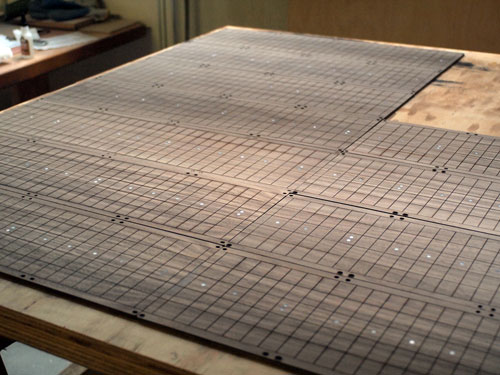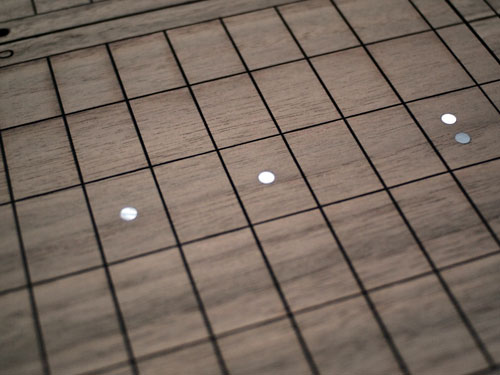randy's Recent Posts
Until the mapping features are added to the software, there are default MIDI controller maps. Pitch is sent out with a combination of note-on and pitch bend. Y is sent out controller 74 (timbre). Z is sent out controller 11 and channel pressure.
Ableton is not the best at dealing with MIDI---it removes the channel information from each note so that the independent pitch bends coming from the Soundplane are lost.
I have never personally tried to use Max for Live, so hopefully someone else will chime in.
I'm working on the user mapping features again now that the hardware is going smoothly, so these should be available soon. Meanwhile let me know what you want to do and I can help you or even add some stopgap features.
I've tried replicating the problem here in Windows 7 64 bit with live 9.0.2 32 bit and everything seems to work no prob for me.
Thanks for the info! This has always been an Audio Units problem only, but actually it's great you said something, because I forgot to tell frankc he can probably use the VST as a workaround.
Hey frankc, you can probably use the Aalto VST in Live as a workaround.
Please see my email.
Hi MD,
Aalto works the same way as all the other plugins in Logic.
To record the output from a plugin in Logic, you need to use the Bounce feature with the [Bnce] buttons on individual tracks. You can look up the Bounce feature in the Logic manual for more info.
The big recording button will record audio and MIDI input to tracks, not plugin output.
Please take the time to go through the Logic manual and learn more about these functions of Logic.
On these forums people use all sorts of different DAW programs, so questions about Logic may go unanswered. People on the Logic forums will definitely be more help.
best,
Randy
So, to be clear, you are playing MIDI notes to Aalto with the computer keyboard in Live. Then when you bring up Aalto’s window, Aalto stops getting the notes?
I have not heard of this happening to anyone since the fix. I will test the OS 10.8 / Live 9 combination when I can, please stay tuned.
What OS, Mac or Windows and what version?
This was fixed in 1.3. If you are still seeing it let me know what OS and versions of Aalto and Ableton.
Did you get my email? I'll copy it here.
Hi Nick,
There is a keyboard event handling problem with Ableton Live that affects Aalto and a few other plugins. I have been working with Ableton to find a fix for this. Hopefully it will be fixed in my 1.3 update coming soon. In the meantime, if you use a MIDI keyboard, you won't have this problem.
-Randy
I have a new free project coming soon that will take the place of Aaltoverb...stay tuned.
After testing some 20 different elastomers, I am currently using a natural gum rubber foam that is even better. It's "Quick-Recovery Natural Gum Foam" in the McMaster catalog. I would try soft or extra-soft. I would also try 1/8" thick.
I'll see about revising the DIY info when I have time, please stay in touch and let me know about your project!
I'll also add what I tell everyone, I recommend you try a 1x1 or 2x2 version first, to make some mistakes and discover interesting things before wiring up a bigger device.
I no longer have Aalto crashes in Max/MSP since we both fixed some bugs. New Aalto (1.3.2) in Max 6 should be stable---if not, let me know and please send crash reports.
Yes, the future is bright, lots to do. A fully modular Aalto-like thing is on the drawing boards.
I'll check into this, thanks for the report.
Lemur Aalto Controller Template Free Download!
Thanks for the generous making and sharing! I have never used Lemur but I know a lot of people use it with Aalto, I look forward to trying this.
Will investigate.
OK, thanks for the further info.
The differences are very subtle. You would have to try hard to hear them.
All the Aalto Solos sound the same, because there is no personalization.
Thanks for the update. It's a case I should be handling better so I still have a note to do something about it.
Thanks for the feedback!
You can get some square wave PWM with the right settings-- look for a "PWM" patch.
I think MIDI out has to be a separate plugin because of the way VSTs work. But I'll look into it.
The +1 and +2 outputs add two more MIDI controllers. They send MIDI CC values m+1 and m+2 into the patcher, where m is the MIDI controller number selected via the "mod" dial.
:-)
I definitely have some plans, but it's a bit soon to talk about them. I would love to see more ideas from different people, of how this ought to work!
Do you have Aalto 1.3.2? This should be fixed in the latest version.
There's a lot going on here at the Labs. While finishing up production on the second run of Soundplanes, I've been able to rewrite the client code that does touch tracking. Here's the result in a very quick and rough demo video. I'm playing a string sound with Aalto over OSC, and simultaneously, a piano with Logic over MIDI.
The new code stores a snapshot of finger pressure at each point on the Soundplane surface. It uses this information to determine what is and what isn't a touch with much better confidence than before. It also normalizes the force over the surface for smoother playing.
Here is a ten minute video walkthrough of the new features, showing how to do the calibration. It picks up a little after I manage to throw away the preferences, but is still probably of interest only to Soundplane owners.
I just uploaded the new client software v0.99. Touch sensitivity over MIDI is finally, very good. I'm working on the additions to the manual to explain the new calibration. Before that I will post a quick walkthrough video. Before that I'll write this:
To get started with v0.99:
First, click "select carriers" on the Expert page to make sure you have the best, least noisy possible carrier set.
Then, click "calibrate tracker" on the expert page and follow the instructions in the status box to the right. Make sure your Soundplane is on a firm, level surface. The object of calibration is to capture the force response across the Soundplane, and capture the shape of a finger touch at each point.
When done calibrating, your Soundplane will return to normal operation. The calibration will be saved with the file "SoundplaneAppState.txt" in Application Support. You should not need to do this "deep" calibration more than one a month or so.
Your Soundplane is now much more sensitive, and also more tolerant to moving around while being played.
There are other new features, which may be self-explanatory. I'm working on the manual to explain them, but if you have any questions in the meantime, I'm here.
Hi, I need more information to help you! First, Mac or Windows?
On Mac, the plugins are always in the same place. On Windows, you have to make sure the install location is correct. You can search on your hard drive for "Aalto" after you install, then make sure the Ableton File / plugin prefs are pointed to that location.
A happy sight: new Soundplane surfaces hot off the laser cutter, ready for sanding and assembly.
These new inlays are mother-of-pearl—photos do not do them justice.
I have never run into this problem. I'll try to reproduce it with a Max patch sending really short MIDI notes.
I think that would work. As always, my advice would be to try a 1x1 junction with the hardware you are thinking of using, and work up from there.
There are many interfaces you could use with the project. It's really open-ended . So yes it's up to you to come up up with as many outputs as you need. You could make a 6x8 surface and use two outputs for sound if you wanted.
The RME I was using had 8x8 plus a headphone out, I think.
There is no filtering on the aftertouch signal. I guess it would be a good thing overall to add it. I'll look at the code and see if there's any reason I can't.
If you use the aftertouch signal with some of the other inputs that have vactrol emulations on them, you will get smoothing there. These are timbre, the gate level and the OSC mod index.

